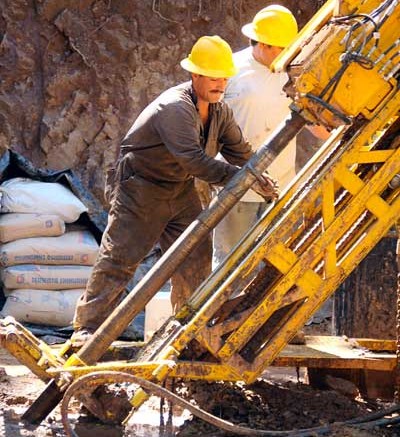VANCOUVER — Paramount Gold & Silver’s (TSX: PZG; NYSE-MKT: PZG) new strategy at its wholly owned San Miguel gold–silver project in northern Mexico’s prolific Palmarejo district is all about lowering capital costs and speeding up development. It means shifting gears from an original preliminary economic assessment (PEA) released in early 2013 that led Paramount to explore a staged mine development that would feature a heap-leach component.
The company’s first step was updating San Miguel’s resources to increase grade confidence and nail down heap-leach recoveries. The result was a resource estimate in early July that boosted measured and indicated gold resources by 76% and silver resources by 44%. Also included was the open-pit San Francisco deposit, where gold recoveries are expected to be 77% from heap leaching.
San Miguel’s global measured and indicated resources now total 43 million tonnes grading 0.81 gram gold per tonne and 56 grams silver per tonne for 1.1 million contained oz. gold and 77.1 million contained oz. silver.
San Francisco accounts for 10 million indicated tonnes at 0.37 gram gold and 10 grams silver for 126,000 contained oz. gold and 3.43 million contained oz. silver, as well as 43.3 million inferred tonnes of 0.32 gram gold and 8 grams silver for 440,000 contained oz. gold and 11.3 million contained oz. silver.
San Miguel’s mineralization is comprised of multi-phase epithermal, low-to-intermediate sulphidation, gold–silver vein, quartz-cemented vein breccia, hydrothermal breccia, and quartz-veinlet stockworks across seven zones, namely: Don Ese, La Union, San Miguel, San Antonio, San Francisco, Monte Cristo and La Veronica.
“We put our heads together and said ‘how do we come up with a plan that will get us into production faster and cheaper?’ We then looked at building some pits because we had a lot of material where we hadn’t quite figured out recoveries,” explains CEO Christopher Crupi during an interview. “Well, we were able to determine a lot of the oxide gold resources were amendable to heap leach, so we rolled out a design with significantly lower upfront costs that has around a six-month window to production from the word ‘go.’ And it’s not too hard to permit in that part of the world, either.”
Paramount’s new plan drops San Miguel’s upfront development costs by 70% to US$69 million from US$163 million, with heap-leach production estimated to reach 4,000 tonnes per day depending on “ore” availability.
The company’s plan for a 4,000-tonne-per-day cyanide mill remains intact, though it has been pushed back until year three in order to make better use of early cash flow.
The change results in San Miguel’s projected sustaining capital jumping to US$346 million, with most of that earmarked for full-scale mill construction.
Overall the mine is expected to produce 55,000 oz. gold and 2.8 million oz. silver annually over a 17-year mine life, with total cash costs pegged at US$855 per equivalent oz. gold.
Technical studies determined that the most suitable mining scenario for the project is an underground operation for the high-grade Don Ese vein; a combination of open-pit and underground mining for La Union and San Miguel; and open-pit extraction for San Antonio, La Veronica, Monte Cristo and San Francisco.
“We’ll obviously still need to raise money for the full mill phase around year three. But I think once you’re in business mining, and people see you’re getting good results, it will be pretty straightforward to arrange that cash for the underground,” Crupi comments.
“We’ve always said we aren’t mine builders, and we’re simply working on creating a value opportunity. Despite the capital markets being where they are, there is still no shortage of serious players poking around for acquisitions.”
Under a base-case scenario that assumes US$1,350 per oz. gold and US$22 per oz. silver, San Miguel now features a US$473-million pre-tax net present value (NPV) at a 5% discount rate, along with a 23% internal rate of return (IRR) and a three-year payback period on initial capital. Paramount’s original US$272 million mine plan featured a US$707-million NPV at a 5% discount rate and a 33% IRR, but assumed a US$1,500 per oz. gold price and US$29 per oz. silver price.
Crupi says that Paramount will move ahead with a proposed US$6.5-million program to bring San Miguel to the prefeasibility stage. The company will also ear-mark US$1.5 million for exploration.
“We have four drill rigs on-site now, which is part of our two-pronged approach moving forward. We’re doing a lot of infill drilling, but we also have some exploration targets that we’re hoping could lead to some satellite discoveries nearby,” Crupi says. “We’ve been picking away at this for a while, and we have some near-surface and underground targets we’re excited about. I can’t say too much right now, but one of them is right near Don Ese.”
Paramount has traded within a 52-week window of 85¢ to $1.79, and closed at $1.09 per share at press time. The company reported US$6 million in working capital at the end of March, and has 158 million shares outstanding for a $174-million market capitalization.
“We’re all believers in the fact gold and silver are going to bounce back, and when that happens these type of projects become incredibly valuable again because the leverage effect is massive,” Crupi says.
“And we have a project here that can be put into production very quickly.”


Be the first to comment on "Paramount’s plan for San Miguel"